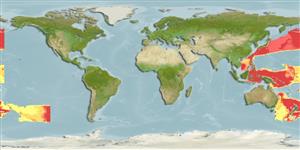Environment: milieu / climate zone / depth range / distribution range
Ecology
Marine; bathypelagic; depth range 600 - 1100 m (Ref. 559). Deep-water
Indian Ocean. Western Pacific: Okinawa Trough and the Philippines.
Size / Weight / Age
Maturity: Lm ? range ? - ? cm
Max length : 21.0 cm SL male/unsexed; (Ref. 559)
Short description
Identification keys | Morphology | Morphometrics
Dorsal spines (total): 0; Dorsal soft rays (total): 45 - 50; Anal spines: 0; Anal soft rays: 65 - 69. Body compressed. Head and body covered with filmy skin. Eye large, circular. Median fins continuous with procurrent fin rays. Lateral line modified ring-like scales. Body color dark-brown.
Life cycle and mating behavior
Maturity | Reproduction | Spawning | Eggs | Fecundity | Larvae
Masuda, H., K. Amaoka, C. Araga, T. Uyeno and T. Yoshino, 1984. The fishes of the Japanese Archipelago. Vol. 1. Tokai University Press, Tokyo, Japan. 437 p. (text). (Ref. 559)
IUCN Red List Status (Ref. 130435: Version 2024-2)
Threat to humans
Harmless
Human uses
Tools
Special reports
Download XML
Internet sources
Estimates based on models
Preferred temperature (Ref.
123201): 4.9 - 8.1, mean 6.2 °C (based on 197 cells).
Phylogenetic diversity index (Ref.
82804): PD
50 = 0.5312 [Uniqueness, from 0.5 = low to 2.0 = high].
Bayesian length-weight: a=0.00347 (0.00163 - 0.00737), b=3.19 (3.00 - 3.38), in cm total length, based on LWR estimates for this (Sub)family-body shape (Ref.
93245).
Trophic level (Ref.
69278): 3.4 ±0.5 se; based on size and trophs of closest relatives
Resilience (Ref.
120179): Medium, minimum population doubling time 1.4 - 4.4 years (Preliminary K or Fecundity.).
Fishing Vulnerability (Ref.
59153): Low vulnerability (16 of 100).
